The Amateur Mycologist Random Find - Probable Crepidotus Genus - A Gorgeous Species With Spores That Defy Macro/Microscopic Expectations
These posts are not for foraging. They are intended for entertainment and intellectual satisfaction only. These posts are not a field guide nor comprehensive in any way - their accuracy is not assured in any way. Do not eat wild mushrooms unless you are a professional, have substantial professional assistance or have a wealth of personal experience with a specific species. Do not make any foraging decisions based on these posts. To do so could be dangerous or life threatening.
This post does not include edibility or toxicity information
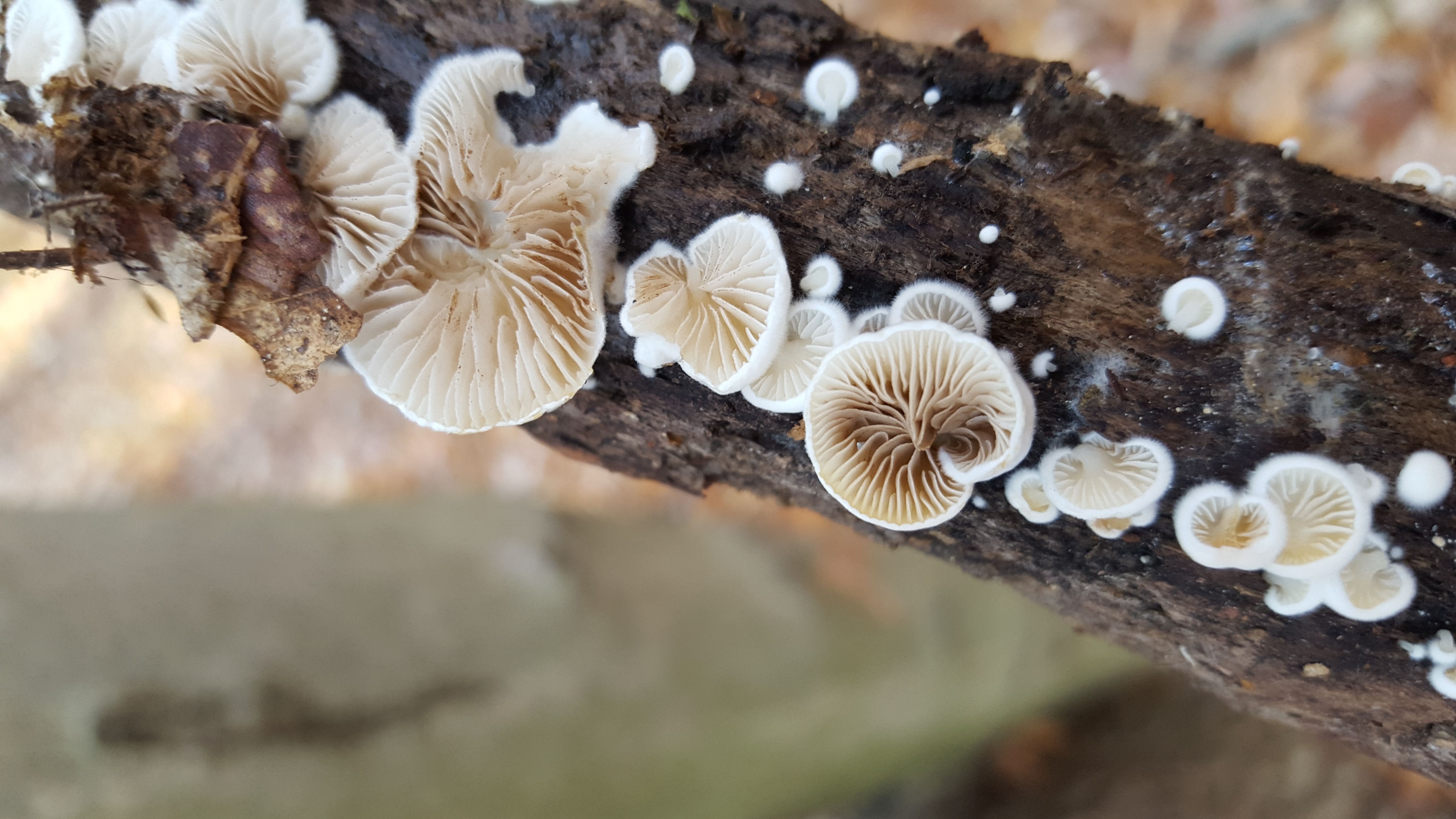
These very beautiful, vaguely "Oyster-like" mushrooms have proven difficult to identify.
Small saprobic mushroom species, like the one highlighted here, often thrive in what amounts to their own little universe. In this case, these pretty, tiny caps were growing en masse on a single small piece of wood. For this particular mycelium, and these particular mushrooms, that piece of wood is their world. The mushrooms will spread their spores and hopefully they will germinate on other pieces of deadwood. But once this log is entirely deteriorated and sapped of its nutrients, so to goes the specific fungal organism that thrived on it.
This particular saprobe falls into a wide range of similar looking species which one can often find growing on small dead branches on the forest floor. The good news is that getting these specimens to a genus is not implausibly difficult. The bad news is that getting to a reliable species identification can be quite hard.
This was another mushroom that required help from the good folks at the New York Mycological Society, and it was two members there who suggested the Crepidotus genus. But, as always, the road to Crepidotus was paved with failed hypothesis, as I try not to simply ask others for an identification without first attempting to achieve one myself. Let's take a closer look and see what conclusions we can draw.
We can see above the beautiful, fairly well spaced, sometimes swirling gills, ranging from white all the way up to brown.
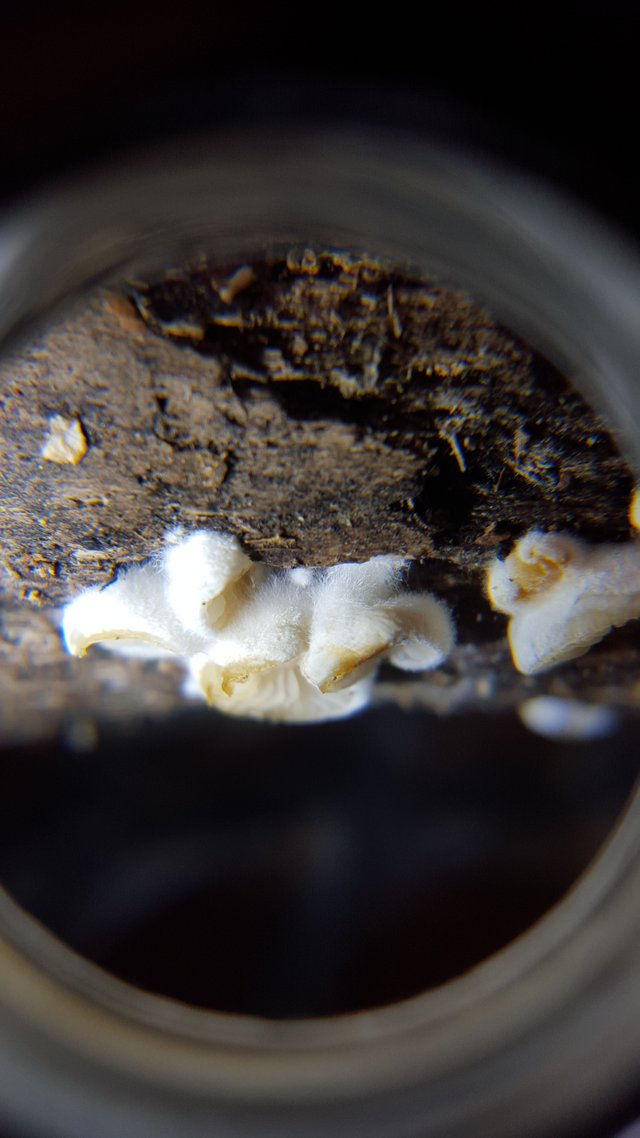
A hand lens reveals the lack of a stem and the downy hairs that covers the cap of this species when young.
I was very pleased with this photo. And I'll take a moment here to point out that all of the photos I take are taken with my cell phone sometimes, like here, augmented by a 20$ hand lens. Eventually I'm going to actually get a decent camera and macro lens. But given what I'm working with I'm pretty satisfied.
Anyway - These are some of the younger caps in profile - they grow directly out of the wood, have no stem, and the cap portion is densely hairy with fine fibers (fibrils if you want to practice using sciency language). The size of the caps pictured in this photo are maybe a little more than 1CM at the largest, and mostly well below that. The largest of the caps in the whole group didn't get larger than 4cm, and most were much smaller.
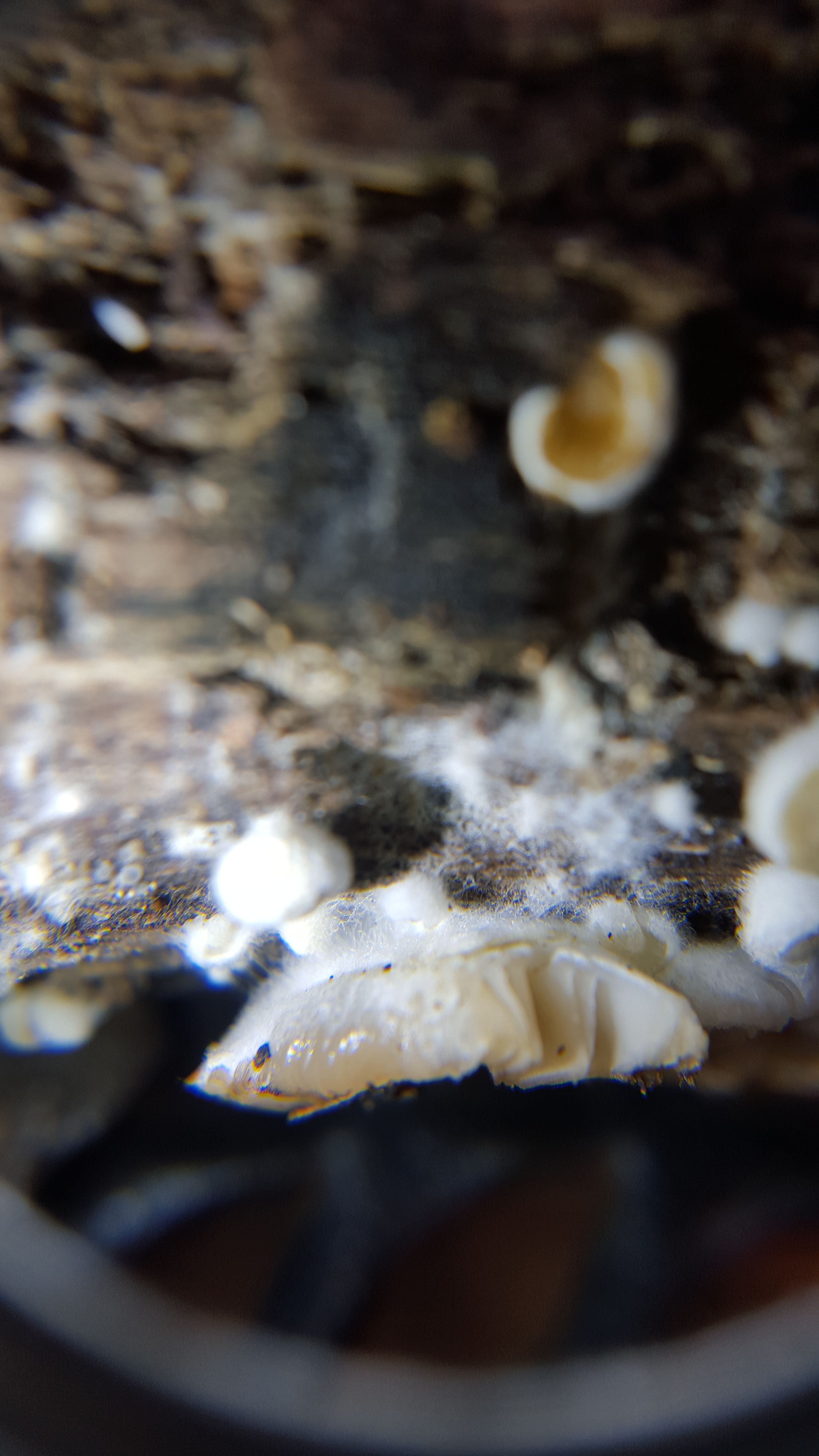
Here you can see a fuzzy white substance extend onto the wood itself.
I believe this is mycelium, possibly either pre-cap formation or an aborted cap formation. Of course this log is infused, through and through, with the actual fungal organism, the mycelium. You'll remember mycelium is usually a hidden, white cobwebby substance from which mushrooms grow when the conditions are right for reproduction.
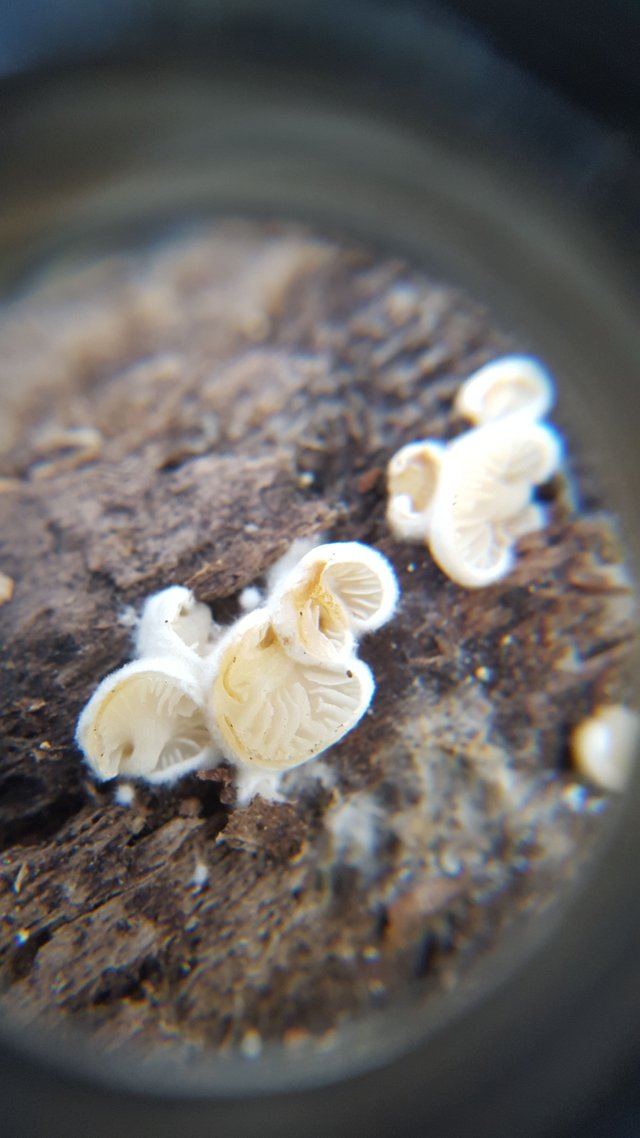
The young gills are almost entirely white
As are many of the more mature gills as well. This originally led me to think these might be what Gary Lincoff refers to in the Audobon guide as "White Oysterettes", or Cheimonophyllum candidissimus. However, the browning gills that did show up, along with the dark spore print and the elliptical spores all militate against that.
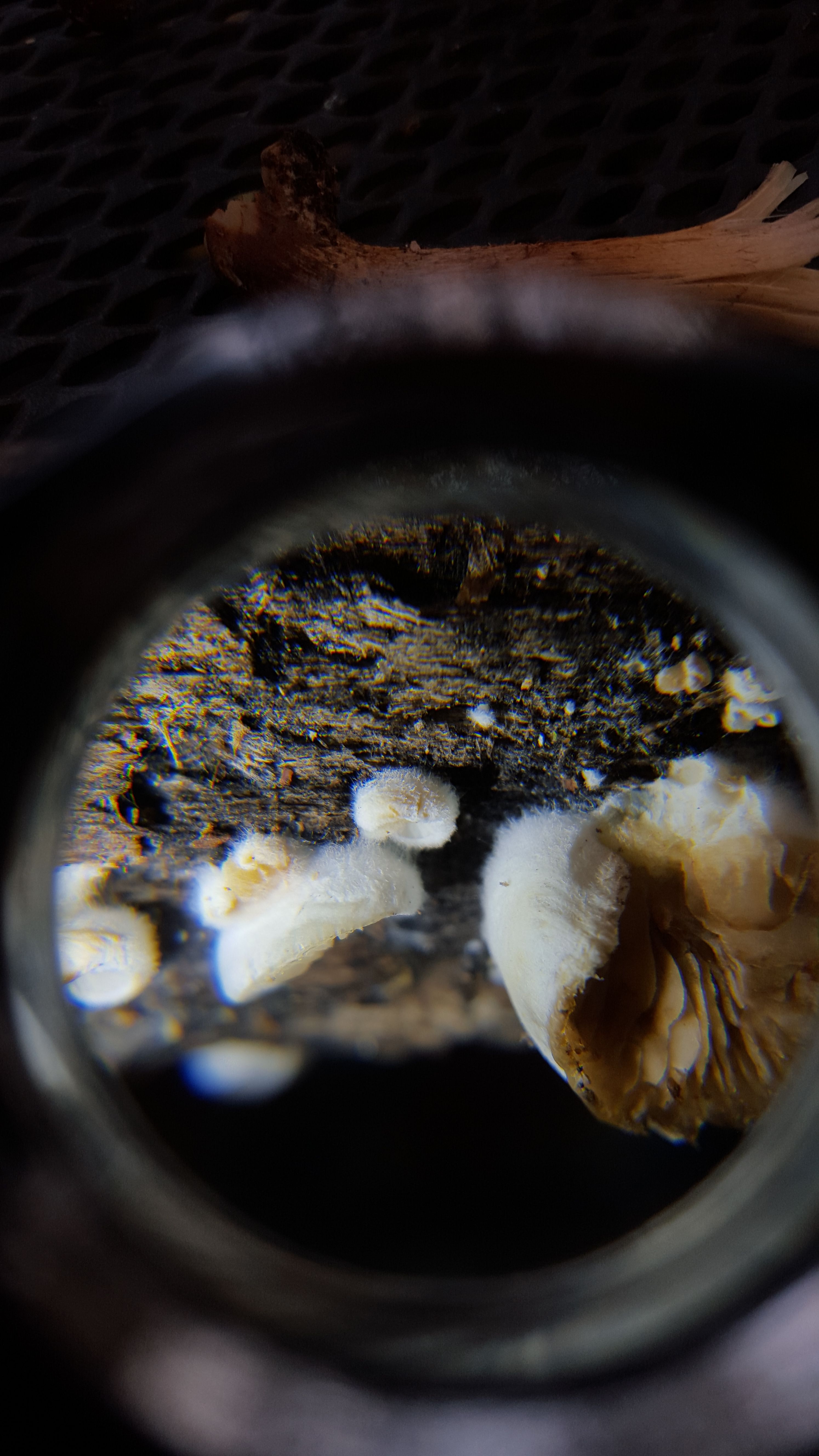
Finally, a close up of an older cap shows the unequivocal darkening transition in the gills.
The cap retains its hairiness, but the gills have browned substantially. Hence not C.candidissimus.
At this point I began going through all of my field guides for a possible answer. The closest I came up with was Claudopus parasiticus. The Claudopus genus definitely includes small, oyster like saprobes which look macroscopically similar, but there were two big problems - and they were both spore related.
Problem One
.jpg)
This spore print is yellow...
That just doesn't fit the bill with any Claudopus species I'm aware of. In fact, this was a big surprise when I first saw it. There's nothing intuitive about nearly perfectly white gilled mushrooms spewing out a dark yellowish spore print, and this again highlights the importance of retrieving a print in order to accurately gauge an ID.
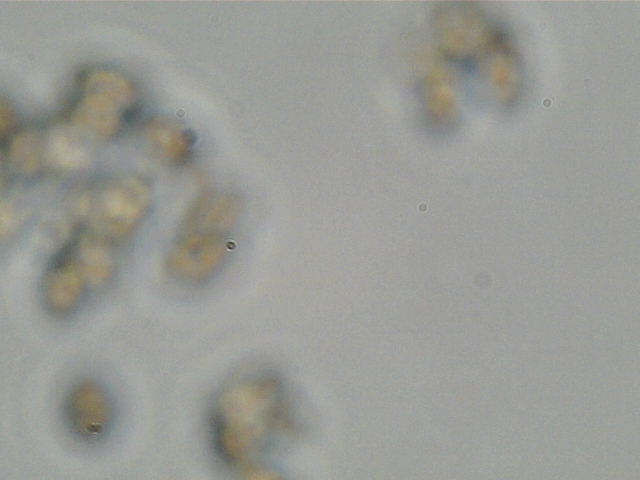
Interestingly, as I've pointed out before, the color of the spores is even visible microscopically when I purposefully leave the image blurry.
You can see the same yellowish tinge in the spores under the microscope. Conclusion - this ain't Claudopus or Cheimonophyllum.
In case there was any doubt, there was also problem two.
Problem Two
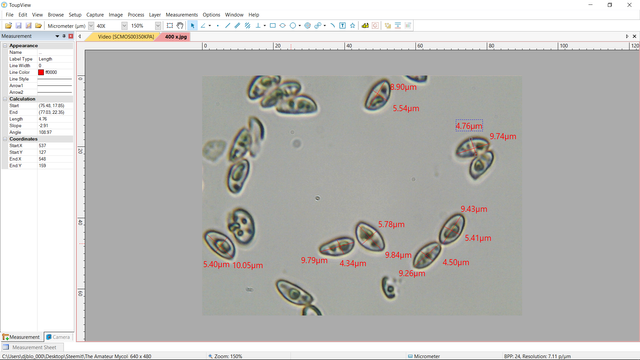
These spore shapes and sizes.
Cheimonophyllum spores are apparently round and have roughly even dimensions, and these are not rounded spores.
The Claudopus species I was considering has spores that are "angular." That means there should be 5 or 6 visible angled edges to the spores. I'm not sure if my scope can capture that kind of detail, but I am very certain that my microscope is getting the dimensions correct.
Claudopus parasiticus runs 9 - 12.5 microns by 8-10.5 microns. As you can see above, the dimensions for these spores simply don't fit that bill at roughly 8-10 microns by 4-5.5 microns, and either elliptical or oblongish.
This left me basically no where
Which meant it was time to enlist the opinion of the good members of the NYMS. That is where the suggestion of Crepidotus was made.
I then found the C. vulgaris species, however I can't confirm that identification. When considering the characteristics of Crepidotus vulgaris, I think it mostly fits the bill, except for the same two problems we had before - the yellow print and the larger than described spore size.
Which is why this is a "Random Find" instead of a species write up. I feel fairly certain this is a Crepidotus mushroom - but as for the species... who the heck knows.
As always, if you're not sure a fungus is what you think it is - or worse yet, what you want to believe it is - then it is better to assume it ISN'T.
THIS POST IS NOT INTENDED FOR FORAGING PURPOSES AND TO USE IT FOR THOSE PURPOSES WOULD BE DANGEROUS. DO NOT HUNT WILD MUSHROOMS WITHOUT RELYING ON A COMBINATION OF PROFESSIONAL FIELD GUIDES, IN PERSON PROFESSIONAL GUIDANCE, OR IN PERSON GUIDANCE BY SOMEONE TRUSTWORTHY WHO HAS COPIOUS LOCAL, SPECIALIZED MUSHROOM HUNTING EXPERIENCE. FAILURE TO DO SO CAN RESULT IN GRIEVOUS PERSONAL HARM OR DEATH.
Photos Are My Own
Microscopic photos were taken using an AMScope M150B entry level microscope. If you use microscopes, I'm quite sure you've never heard of this model - but its cheap and available on Amazon. The camera lens is also AMScope, MD35 - by far their crappiest microscope camera. But, still capable of material, relevant, and in some cases, dispositive, data collection. Lastly it should be noted that the precise magnifications are not easily deduced using the camera - but based on relative spore sizes compared to known microscopic photos from Kuo and other sources, I estimate 40, 100 and 400x.
Information Sources
[1]Kuo, M. (2009, April). Crepidotus vulgaris. Retrieved from the MushroomExpert.Com Web site
[2]Kuo, M. (2015, May). The genus Crepidotus. Retrieved from the MushroomExpert.Com Web site
As always great to read your posts @dber, these mushrooms seem particularly delicate and very beautiful. Nice job on catching mycelium in that photo. Can't wait to see what photos you'll capture with a better camera.
I imagine there would be a learning curve - but at the end of the day it really couldn't get worse than my current ragtag set up
Wow tiny little beauties :)
Aren't they? Buying the hand lens has opened up some really awesome images of tiny mushrooms i would never even have looked for. Next week is going to be all slime molds - i bought a book about them and colected two awesome samples. The smaller you get somehow the more beautiful the structures become.
Thanks for sharing your explorations. Always inspiring photography.
Thank you for always taking a gander!
Seems like you found a new species Crepidotus dbersteemicus!
Haha - I often imagine what it would be like to find a new species, but then I am reminded by research of the immense scrutiny placed on fungal identification for the last hundred years or so.
Actually though, the chances of discovering a new species increase proportionally with your distance from known hot beds of mycologicaly study. New York city and Long Island have been put through the observational ringer for generations - but if you live in a remote area and are diligent and consistent, you could well find something new.
Now, it is unlikely to be extraordinarily, explosive looking in its newness. But it might nonetheless be an unclassified species.
Now, if you go down the rabbit hole further and study local myxomycetes, or slime molds, then the chances of finding a new species - or at least a new ecology - skyrocket relatively speaking. But more on that next week!
Very intresting as usual. You are doing a great work there ;)
Thanks for reading.
Wow. very very nice photography. my big brthar i like post & resteem this post!
excellent post I love, greetings I follow you when you want to go through my profile. Thank you.